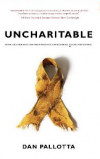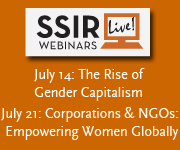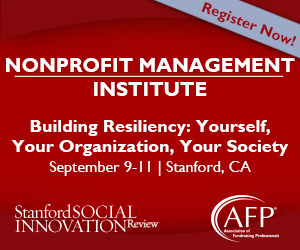ISSUE
Articles on social change from the latest edition of SSIR

Spring 2009
Volume 7, Number 2
Climate change is now widely recognized as one of the world’s most pressing problems. As governments at all levels struggle to address the issue, individuals have begun taking matters into their own hands by purchasing carbon offsets from companies that invest in renewable energy, plant trees, or reduce emissions. The spring 2009 issue of Stanford Social Innovation Review explores how individuals are atoning for their use of cars, air travel, and even funerals in “Offsetting Green Guilt.”
Features
Shades of Green
Social networking tools reveal that there is an intricate web of relationships between business and environmentalists, which if developed could benefit the environmental movement.
Ten Nonprofit Funding Models
For-profit executives use business models—such as "low-cost provider" or "the razor and the razor blade"—as a shorthand way to describe the way companies are built and sustained. Nonprofit executives are not as explicit about their funding models and have not had an equivalent lexicon—until now.
Offsetting Green Guilt
Voluntary carbon offsets allow people to invest in projects that allegedly counteract their greenhouse gas emissions. But can voluntary offsets help slow global warming? Or are offsets a way for consumers to buy their way out of bad feelings?
Creating Social Value
The idea that social entrepreneurs create something called social value—good works that go above and beyond what traditional entrepreneurs and businesses deliver—is a dearly held tenet of the social change movement. But what exactly is social value, and how do social entrepreneurs go about creating it?
What's Next
The Pepsi Spirit—of Giving Back
Pepsi's free CSR: enrolling more than 27,000 of its U.S. employees in the Wireless AMBER Alert Program.
Social Entrepreneurs Take the Leads
Skoll and Sundance hope documentary films prove powerful in making social change.
Polling Power
A new Web site shows voters who like-minded peers, organizations, and opinion leaders support.
Texting It In
A free, open-source software package lets health care workers in developing countries better fight disease.
Field Report
Millennials MoveOn
To propel young folks to the polls, a political organization mixed Web 2.0 tools with social science savvy.
Tongue-Tied at the Top
While boards sat in silence, executives milked American University and the Smithsonian.
Root Solutions
Nonprofit lender Root Capital connects rural farmers and artisans with the corporations that crave their products.
Case Study
Clear Blood
By 1998, thousands of people had contracted HIV and hepatitis C from Canada’s tainted blood supply. To restore the supply and the public’s trust, the federal, provincial, and territorial governments of Canada created a new organization, Canadian Blood Services. Despite the public health tragedy that it inherited, Canadian Blood Services rebuilt Canadians’ faith in the nation’s blood supply by infusing transparency into its structure, culture, and operations.
Viewpoint
Fundraising in Tough Times
Our economy is in bad shape and will only get worse. So what can fundraisers do to minimize the impact of this difficult period on our organizations, and at the same time maximize income?
Research
Busy Jobs Send Most Volunteers
Research finds that men in busy jobs are the most likely to donate their time to volunteer.
Saving Lives, Not Just Souls
New research estimates the value of the services provided by faith-based organizations.
No Profit for Her
Research shows that men may be more effective than woman at utilizing microfinance investments.
Partners Must Start Smart
Starting on the right terms fosters the trust necessary for partners to work together over the long haul.
Books
The Double Standard
Uncharitable: How Restraints on Nonprofits Undermine Their Potential by Dan Pallotta
It’s the Destination
The Blue Sweater: Bridging the Gap Between Rich and Poor in an Interconnected World by Jacqueline Novogratz
The Art of Grantmaking
Money Well Spent: A Strategic Plan for Smart Philanthropy by Paul Brest and Hal Harvey
 → This form is for US/Canada subscribers. Are you an international subscriber?
→ This form is for US/Canada subscribers. Are you an international subscriber?
Click here instead.
Subscribe Now!
Subscribers get premium online access (articles with a key) including 9-year archive, downloadable digital edition, quarterly print issues (optional).






























































